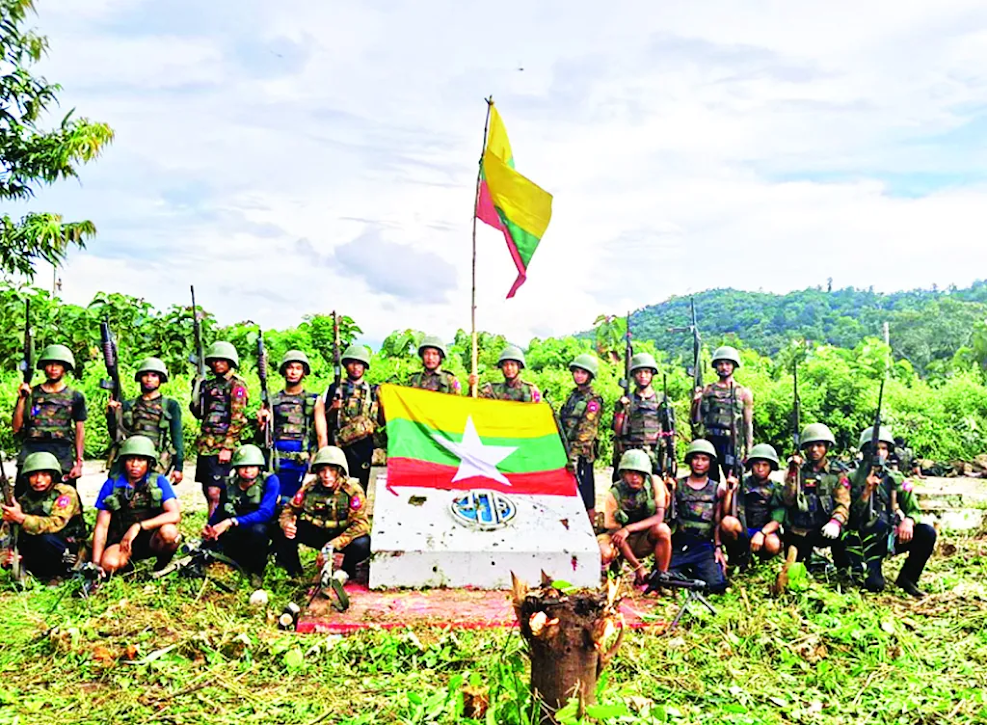Myanmar Spring Chronicle – View from September 10
(MoeMaKa), September 11, 2025
The Karen State front: rapid penetration by Military Commission forces
After more than 500 days in which the Asia Highway linking Myawaddy and Kawkareik—crossing the Dawna Range—had been held by KNU/KNLA and allied forces, troops of the Military Commission advanced in roughly three columns in August. They broke through the year-plus blockade and, in the first week of September, seized control of the Asia Highway and reached the strategic base at Thingannyinaung.
As the “Aung Zeya” operation columns pushed toward Thingannyinaung, Military Commission troops stationed with Light Infantry Battalion (LIB) 275—the Myawaddy garrison—provided supporting fire with heavy weapons. In April last year, KNU/KNLA joint forces captured the Thingannyinaung strongpoint together with nearby regiments and even LIB 275. However, the Border Guard Force (BGF) led by Saw Chit Thu—renamed the Karen National Army (KNA)—intervened and took over LIB 275, enabling junta troops to re-enter and reoccupy.
Relations among Karen armed factions are hard to read—not only because of differing political positions and policies, but also because some groups root their stance in “Karen nationalism.” Unlike certain ethnic armed organizations that insist there should be only one Karen armed group under one party, the KNU does not hold to so rigid a view, which adds to the complexity.
Since independence, the Karen National Union—the earliest post-independence armed resistance—has experienced many ups and downs. Early last year the KNU/KNLA controlled Kawkareik and stretches of the Asia Highway, and came close to taking Myawaddy town and the border trade gate. The BGF stepped in, however, and for over a year held parts of Myawaddy. During that period the KNU/KNLA seized one junta border outpost after another along the Karen–Thailand frontier, imposing continuous military losses on the junta.
In recent months, the junta prepared counteroffensives to retake lost towns, areas, and bases in northern Shan, Kachin, Kayah, and Karen States. While currently mounting operations in northern Shan, it is simultaneously aiming in Karen State to reassert control over the Asia Highway and Myawaddy.
Having re-entered Thingannyinaung this time, Military Commission troops have also advanced within days to areas south of Myawaddy such as Lay Kay Kaw and Lakkhat Taung; reports on September 9 said they had reached Lakkhat Taung. On September 10, further reports said junta troops were moving to take positions at Myawaddy Bridge No. 1. Since late April 2024, civilian departments (like immigration and customs) had been present at Bridge No. 1, but junta combat units had been unable to maintain positions in the town for over a year. With the Asia Highway and Thingannyinaung now seized, they appear to be preparing to bring the town back under full control.
Because KNU/KNLA and allied forces had held areas, camps, and the Thingannyinaung strongpoint in Myawaddy Township for more than a year, questions are being raised as to why the Military Commission could recapture them so quickly in recent weeks. Was it that KNU/KNLA could not mount a strong defense due to shortages of ammunition? Was it not only the junta’s numerical superiority but also its extensive use of drones and aerial munitions? Or did Karen armed groups familiar with the terrain—such as the BGF or DKBA—assist by guiding or otherwise helping? It may well be a combination of these factors.
For the KNU/KNLA, controlling areas like Myawaddy–Kawkareik and Kyon Doe is not only about customs revenue from border trade; it also provides territory that lets political-military allies live and operate. Although the KNU/KNLA has bases and activities not only in Karen State but also parts of Mon State and in eastern Tanintharyi and Bago, the eastern flank of Karen State—especially Myawaddy District—remains the most critical.
Given the junta’s swift offensive and the territory and camps it has just seized, KNU/KNLA counter-attacks—fast or slow—are likely to emerge. At the same time, under the pretext of the upcoming election, the Military Commission will probably continue efforts in the near term to retake towns, territory, and bases.

